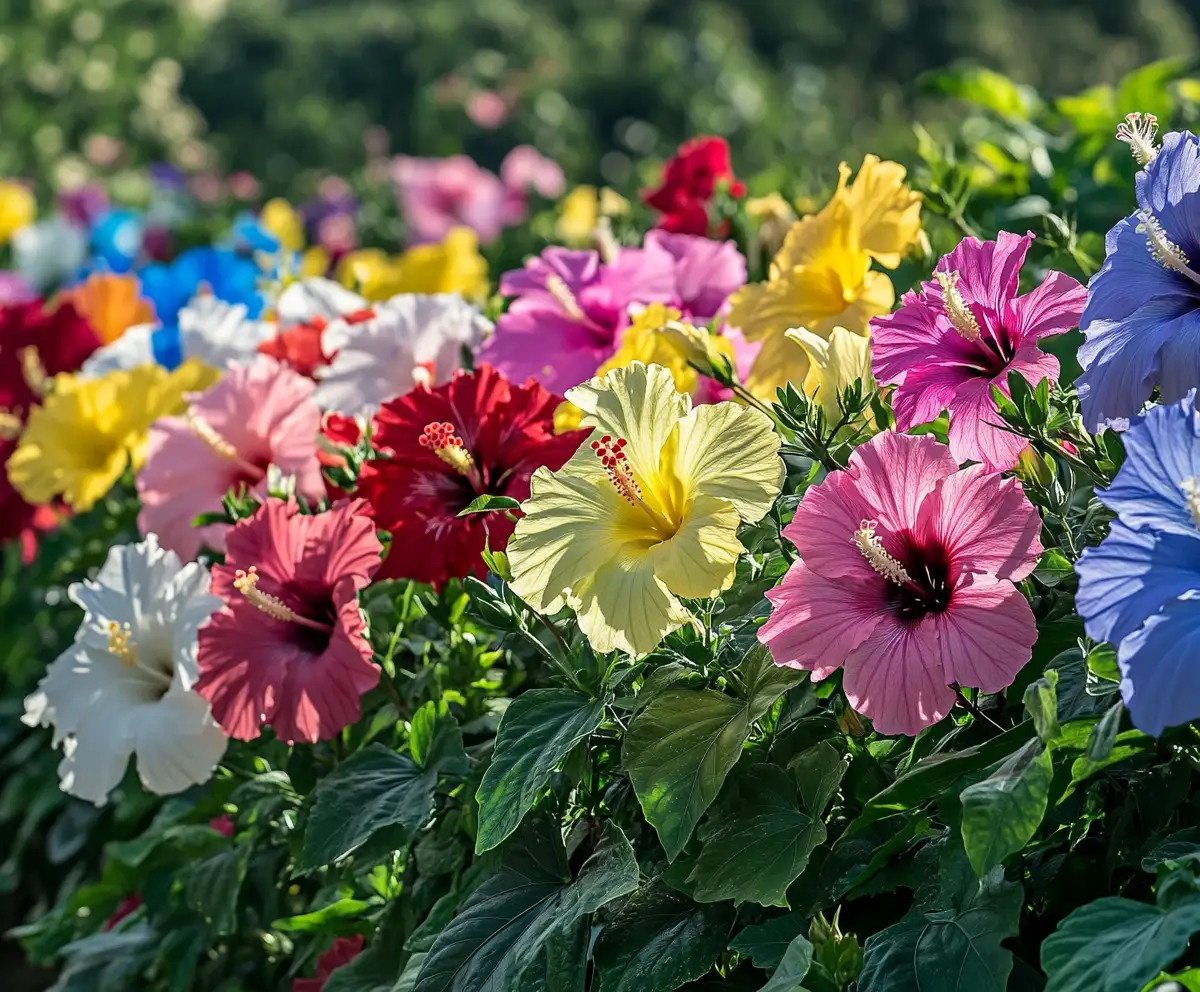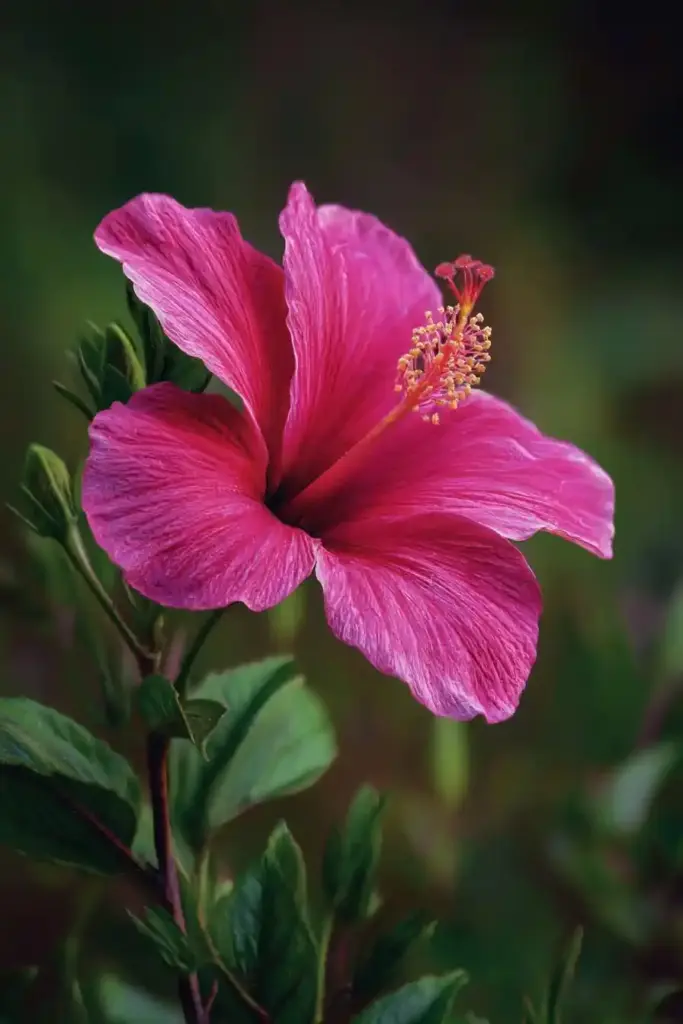Hibiscus flowers are among the most stunning blooms you can grow, known for their large, colorful petals and tropical appeal. Whether you’re designing a vibrant flower bed or seeking a statement piece for your patio, hibiscus offers a dazzling palette of colors—from soft whites and romantic pinks to fiery reds and regal purples. With the right varieties and care, you can enjoy these floral showstoppers throughout the growing season.
In this guide, we’ll explore the most popular hibiscus flower colors and the best varieties to choose for each shade, helping you create a garden that’s bursting with color and life.
Types of Hibiscus: Choosing the Right Fit for Your Garden
Before we dive into color choices, it’s helpful to understand the two primary types of hibiscus you’ll encounter in gardening:
Tropical Hibiscus (Hibiscus rosa-sinensis)
- Large, exotic blooms in a wide range of vibrant colors
- Best for USDA Zones 10–12
- Loves full sun and warm temperatures
- Ideal for patios, containers, or as focal points in subtropical landscapes
- Blooms from spring through fall
Hardy Hibiscus (e.g., Hibiscus moscheutos, Hibiscus syriacus)
- Known for massive, dinner-plate-sized flowers
- Cold-tolerant down to USDA Zone 4
- Blooms from mid-summer through fall
- Excellent for borders and wet garden spots
- Can survive winter and return each year
With that in mind, let’s explore the vibrant world of hibiscus flower colors to inspire your garden design.
Purple Hibiscus: Add a Touch of Royalty to Your Garden
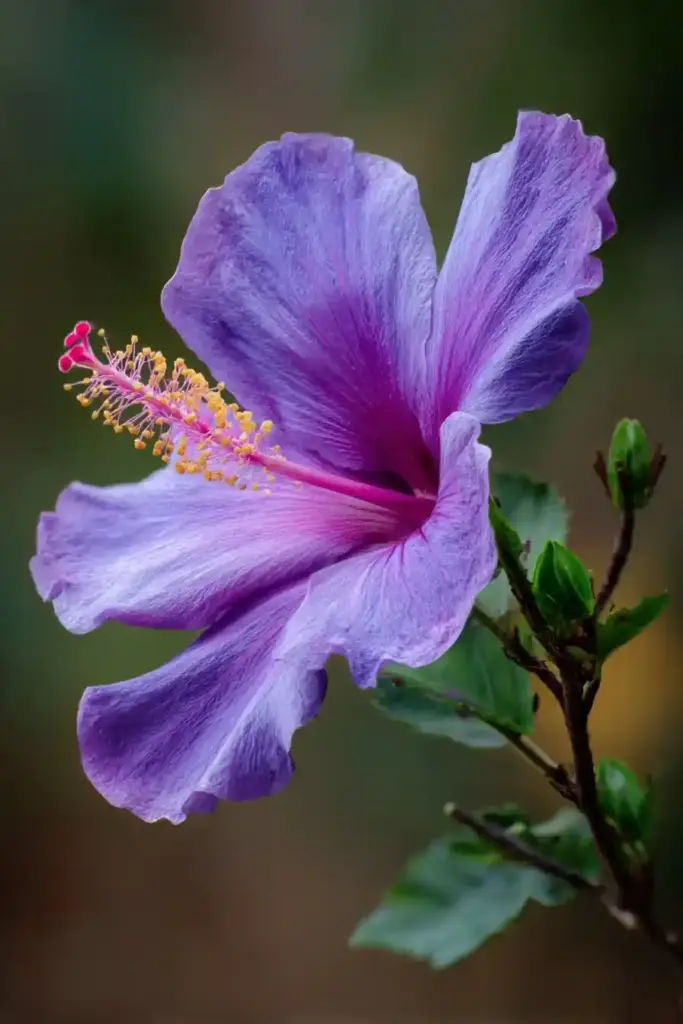
Purple hibiscus blooms are truly captivating—perfect for gardeners looking to add depth, drama, and elegance to their outdoor space. Ranging from soft lavender to deep violet, these flowers create a rich and luxurious vibe. Many varieties also feature darker eyes or veining that enhance the contrast and visual impact.
Top Purple Hibiscus Varieties
Hibiscus ‘Berry Awesome’ (Rose Mallow)
- Enormous lavender-pink blooms up to 8 inches wide
- Vivid red centers for striking contrast
- Compact growth habit, ideal for containers and borders
- Blooms from mid-summer through fall
- Beautiful dark green foliage enhances its vibrant flowers
Hibiscus ‘Lilac Crush’
- Huge lilac flowers with overlapping petals
- Consistent, heavy bloomer from summer into late fall
- Upright growth, perfect for back-of-border planting
- Creates a calming, dreamy garden vibe
Hibiscus syriacus ‘Lavender Chiffon®’ (Rose of Sharon)
- Bushy shrub with elegant double lilac-pink flowers
- Delicate darker veining at the petal centers
- Blooms profusely from late summer into fall
- Works well in structured landscapes or as a flowering hedge
Garden Tip: Purple hibiscus pairs beautifully with silver or gray foliage plants like lamb’s ear or dusty miller to emphasize its cool tones and create a layered, sophisticated garden look.
Yellow Hibiscus: Brighten Your Garden with Cheerful Blooms
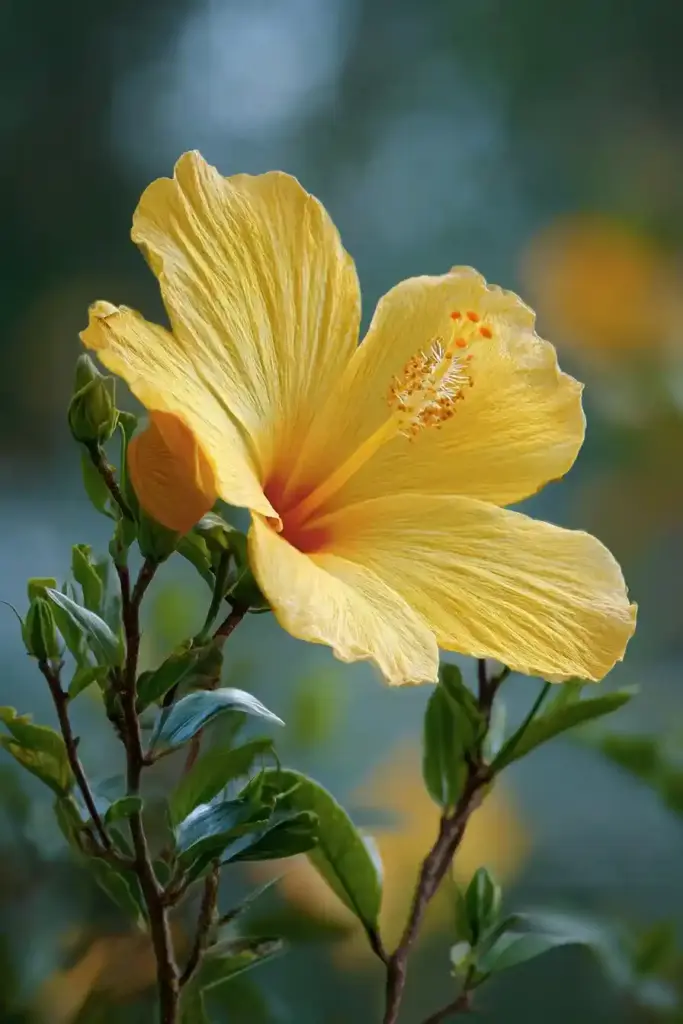
Yellow hibiscus flowers radiate warmth and positivity. These sun-kissed blooms range from pale buttery tones to deep, golden hues—perfect for lifting the mood of any outdoor space. Their cheerful color stands out beautifully against lush green foliage and works especially well in tropical-themed or pollinator-friendly gardens.
Top Yellow Hibiscus Varieties
Hibiscus aculeatus (Comfortroot)
- Native perennial with blooms that transition from cream to yellow to soft pink
- Flowers feature pleated, scalloped petals and a deep purplish-red center
- Blooms from late spring through fall
- Attracts butterflies and native pollinators
- Ideal for moist garden areas or wildflower landscapes
Hibiscus brackenridgei (Mao Hau Hele)
- The official flower of Hawaii 🌺
- Produces large, vibrant yellow flowers (4–6 inches wide)
- Can bloom intermittently all year in warm climates
- Grows as a shrub or small tree—perfect as a tropical accent
- Adds a breezy island vibe to any landscape
Hibiscus rosa-sinensis ‘Hula Girl’
- Tropical hibiscus with bold yellow petals and a vivid red center
- Almost year-round bloomer in warm climates
- Great for containers, patios, or tropical gardens
- Bonus: the edible flowers are used in salads and drinks in Pacific Island cultures
Design Tip: Plant yellow hibiscus alongside purple or red varieties for a vibrant, high-contrast display that pops from across the yard.
Blue Hibiscus: Rare Blooms with a Cool, Elegant Charm
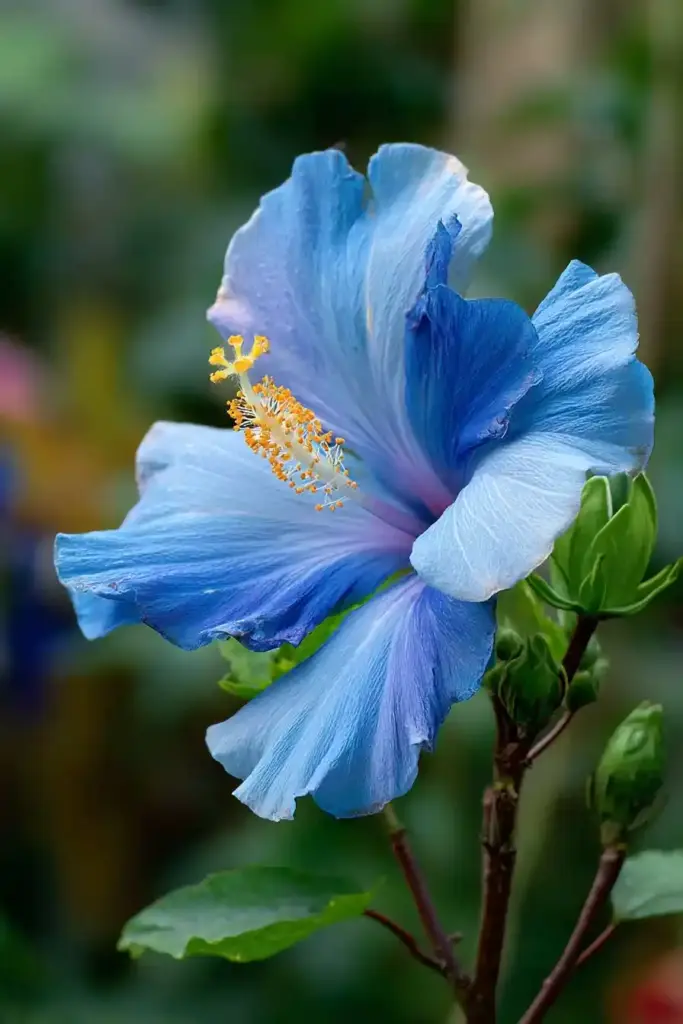
Though true-blue flowers are rare in the plant world, several hibiscus varieties offer shades of violet-blue and soft azure that give the illusion of blue. These cool-toned blossoms bring an air of tranquility and elegance, making them perfect for adding contrast to warm-colored flowers or calming spaces in your garden design.
Top Blue Hibiscus Varieties
Hibiscus syriacus ‘Marina’ (aka ‘Blue Satin’)
- Violet-blue, hollyhock-like blooms with rich reddish-purple centers
- Flowers are 4 inches wide and bloom from midsummer through fall
- Dense, upright shrub ideal for back-of-border structure
- A great option for mixed flower beds needing a cool-toned anchor
Hibiscus syriacus Blue Chiffon®
- Award-winning shrub with semi-double, pale blue flowers
- Each bloom features a delicate red-purple “starburst” at the center
- Blooms continuously from midsummer to fall
- Adds softness and texture to garden designs with its frilly petals
Hibiscus syriacus ‘Ultramarine’
- Deep violet-blue single blooms with a dark red throat
- 4-inch flowers appear from midsummer into early fall
- Maple-like green foliage offers contrast and structure
- Excellent for borders, hedges, or as a vertical accent
Pro Tip: Pair blue hibiscus with silver, white, or pastel-colored flowers to create a serene “moon garden” effect that glows beautifully at dusk.
Red Hibiscus: Bold, Passionate Color for a Striking Garden Display
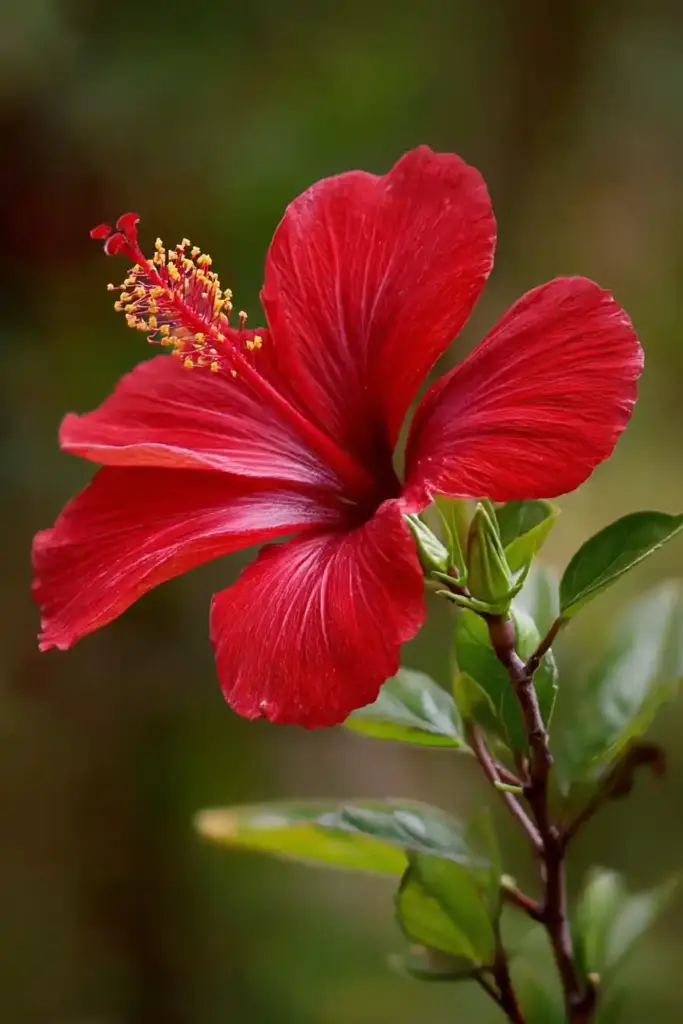
Red hibiscus flowers are show-stoppers. Whether you go for deep burgundy or bright scarlet, these bold blooms add drama and excitement to any garden space. Their rich color draws the eye instantly and looks stunning against dark or green foliage—perfect for making a powerful statement.
Top Red Hibiscus Varieties
Hibiscus ‘Holy Grail’ (Rose Mallow)
- Compact perennial with enormous deep red blooms (up to 9 inches!)
- Velvety, nearly black foliage offers jaw-dropping contrast
- Blooms continuously from midsummer through fall
- A true centerpiece plant for any flower bed or container
Hibiscus ‘Midnight Marvel’
- Scarlet red blossoms up to 9 inches across
- Deep wine-purple, maple-shaped leaves provide a moody backdrop
- Profuse blooming from midsummer to fall
- Ideal for dramatic borders or bold mixed plantings
Hibiscus moscheutos ‘Luna Red’
- Hardy hibiscus with burgundy-red, dinner plate-sized flowers
- Blooms measure 6–8 inches and feature creamy white stamens
- Compact and bushy—great for small gardens or tight spots
- Fast bloomer with fresh flowers opening daily throughout the season
Landscape Tip: Use red hibiscus to create focal points or accent entrances. Pair with yellow or orange companions for a sizzling, tropical palette.
White Hibiscus: Pure Elegance for a Clean, Sophisticated Garden Look
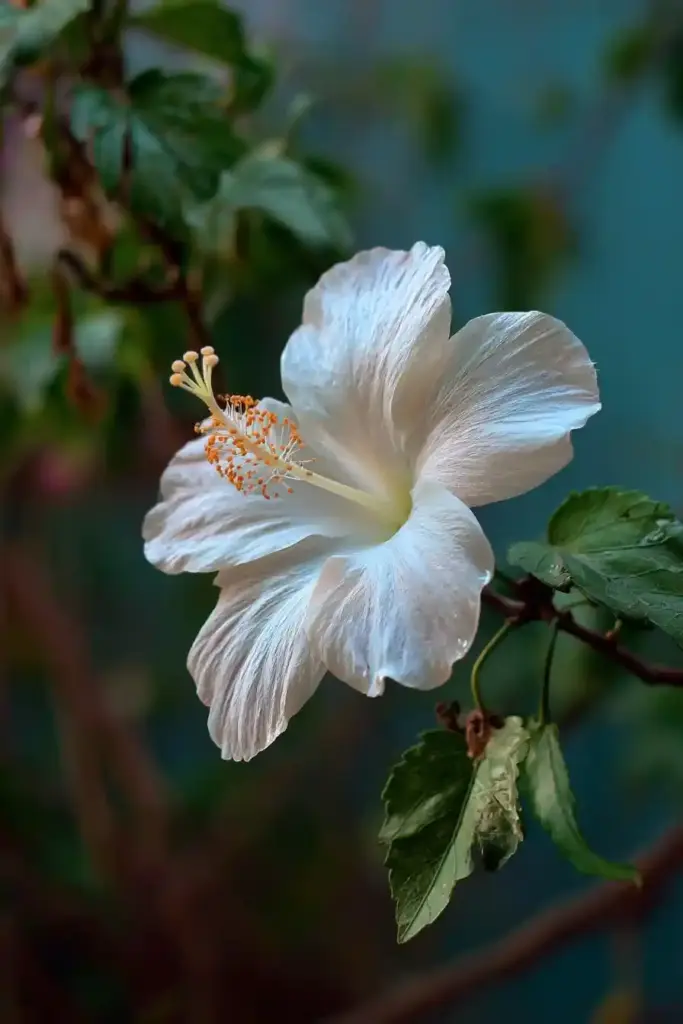
White hibiscus flowers offer a fresh, refined aesthetic. Whether your garden style leans modern, cottage, or tropical, these crisp blooms fit right in. Ranging from creamy tones to bright snow-white petals, white hibiscus adds a cooling effect, especially in contrast with darker foliage or more vivid flower colors.
Top White Hibiscus Varieties
Hibiscus laevis (Halberd-Leaved Rose Mallow)
- Upright perennial with broad white petals and a dramatic maroon or purple throat
- Flowers can grow up to 6 inches wide
- Distinctive leaves shaped like medieval halberds add extra character
- Perfect for wet areas like bogs, pond edges, or rain gardens
Hibiscus lasiocarpos (Woolly Rose Mallow)
- Native to the southern U.S. with soft white or pale pink petals and bold red centers
- Fuzzy, heart-shaped leaves add texture to the plant
- Blooms from mid-summer through fall
- Thrives in wetland gardens, naturalized areas, and wildlife-friendly spaces
Hibiscus syriacus White Chiffon®
- Award-winning shrub with elegant double white flowers (4 inches across)
- Blooms continuously from late summer into fall
- Adds structure and brightness to the back of garden borders
- A clean, classic look that plays well with both bold and pastel palettes
Garden Design Tip: Use white hibiscus to break up intense color groupings or brighten shaded areas. They also make excellent companions in moon gardens designed to glow under evening light.
Pink Hibiscus: A Romantic Touch for Gardens Full of Charm
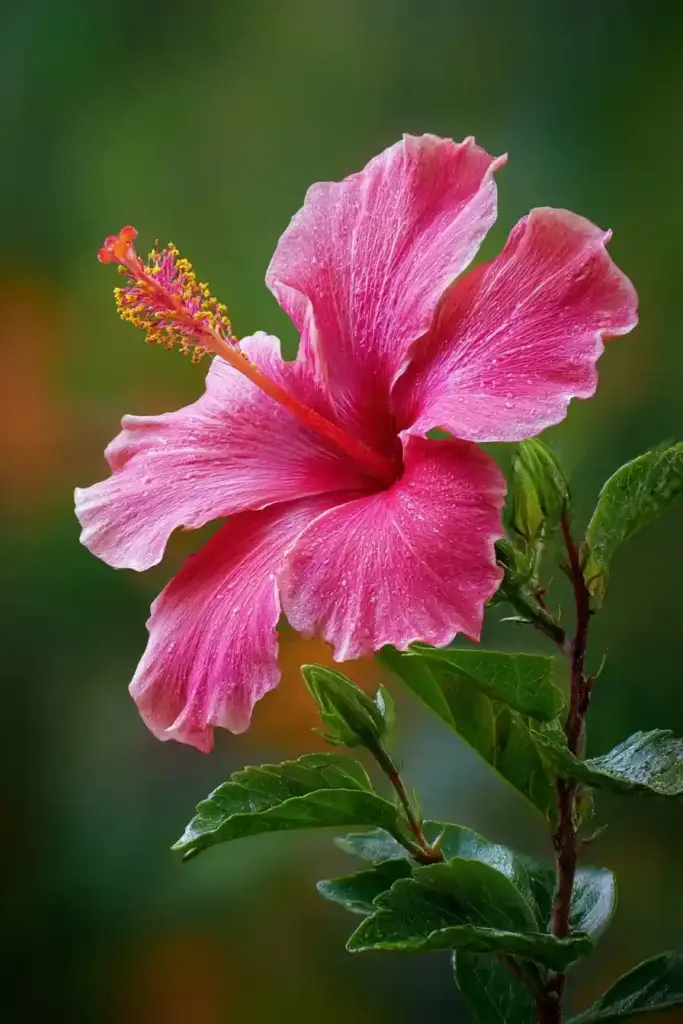
Pink hibiscus flowers are a favorite for their sweet, soothing vibe and wide spectrum of shades—from delicate blush to electric fuchsia. They bring a romantic softness to flower beds, borders, and patio containers, and pair beautifully with nearly every garden color scheme. Whether you want whimsy or bold elegance, pink hibiscus delivers.
Top Pink Hibiscus Varieties
Hibiscus ‘Edge of Night’
- Compact variety with vivid bubblegum-pink blooms (7–8 inches wide)
- Contrasts beautifully with jet-black, oval foliage
- Blooms from midsummer through early fall
- Ideal for borders, containers, or small space gardens
Hibiscus ‘Kopper King’
- Massive light pink flowers up to 12 inches across!
- Each bloom features dramatic red veining and a bold red eye
- Copper-red foliage provides rich contrast
- A standout in sunny garden borders or as a floral focal point
Hibiscus mutabilis (Confederate Rose)
- Unique blooms that shift color over the day—from white or light pink in the morning to deep pink or red by evening
- Single or double blooms reach 4–6 inches across
- Large, fast-growing shrub or small tree
- Blooms profusely from late summer through fall, adding dynamic beauty to the late-season garden
Bonus Appeal: Pink hibiscus varieties often attract pollinators like hummingbirds and butterflies, turning your garden into a lively, colorful sanctuary.
How to Care for Hibiscus Plants: Keep Your Blooms Thriving
Whether you’ve chosen tropical or hardy hibiscus, proper care is essential for lush foliage and continuous blooms. Here’s how to keep your hibiscus plants looking their best throughout the growing season.
☀️ Light Requirements
- Outdoor Hibiscus:
- Needs at least 6 hours of sunlight daily
- In hot climates, some afternoon shade can prevent leaf scorch
- Indoor Hibiscus (Tropical varieties):
- Place near a bright window (south or west-facing is ideal)
- Avoid harsh midday sun without acclimating gradually
🌱 Soil Preferences
- Well-drained, fertile, and slightly acidic soil (pH 6.0–6.5)
- Hardy hibiscus tolerates moist or even boggy soils—great for rain gardens
- Add compost or organic matter to boost drainage and nutrients
💧 Watering Tips
- Keep soil consistently moist, especially during hot months
- Use mulch to retain moisture and suppress weeds
- For potted hibiscus:
- Let the top inch of soil dry out before watering again
- May need daily watering in summer
🌡️ Temperature & Humidity
- Hardy Hibiscus: Can survive temps down to -30°F (-34°C)
- Tropical Hibiscus: Sensitive to cold; bring indoors if temps drop below 50°F (10°C)
- Loves humidity—consider using a pebble tray or humidifier indoors
🌿 Fertilizing Routine
- Use a balanced fertilizer (like 10-4-12 or 12-4-18)
- Hardy varieties: Feed in early spring, after first bloom, and midsummer
- Tropical types: Fertilize monthly during growing season
- Opt for water-soluble fertilizer for quick absorption
✂️ Pruning & Maintenance
- Prune in early spring to shape and promote new growth
- Remove dead or weak stems anytime during the year
- Hardy types die back in winter—cut down dead stems before spring growth returns
🌱 Propagation Tips
- From Cuttings: Great for most varieties—snip a 4–6 inch stem and root in water or moist soil
- From Seed: Best for swamp or wild hibiscus; others may not stay true to parent plant
🪴 Potting & Overwintering
- Repot every 1–2 years in early spring with fresh soil
- Use shallow, wide containers to encourage more blooming
- For overwintering tropical hibiscus:
- Bring indoors before frost
- Cut back on watering and stop fertilizing until spring
🐛 Pest & Disease Watch
- Common pests: aphids, whiteflies, and spider mites
- Treat with neem oil or insecticidal soap if needed
- Keep foliage dry and clean to avoid fungal issues
Conclusion: Create a Garden That Bursts with Color and Personality
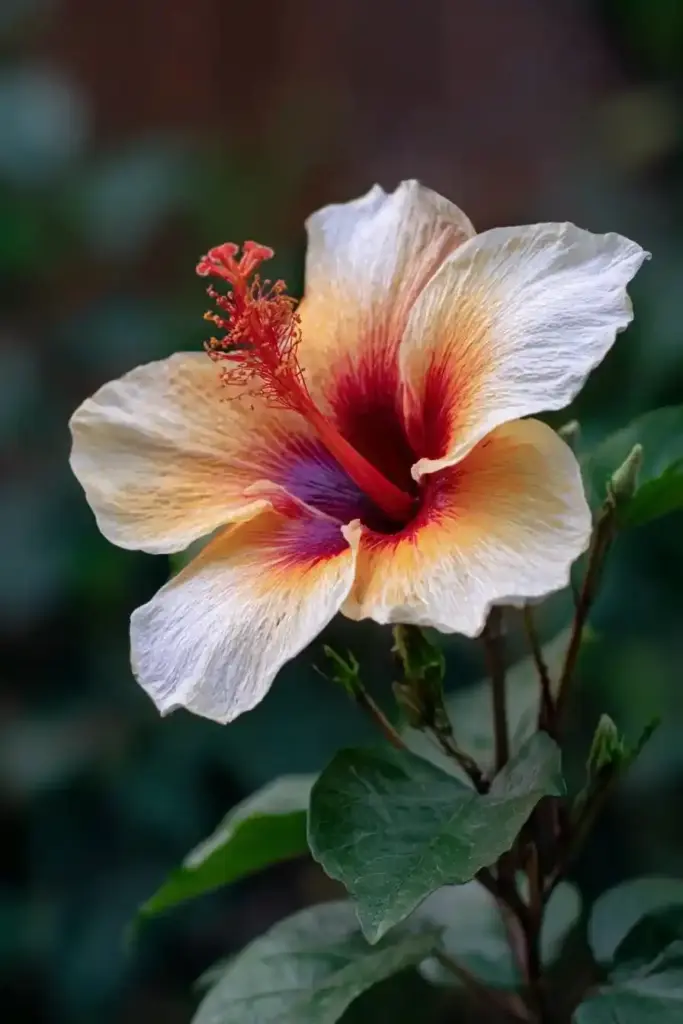
Hibiscus flowers offer one of the most stunning color palettes in the gardening world—from dreamy lavenders and bold reds to cheerful yellows and crisp whites. By selecting the right types for your climate and garden style—whether it’s tropical or temperate—you can enjoy these spectacular blooms all season long. With just a little care and attention, your hibiscus will reward you with color, texture, and tropical flair that turns your outdoor space into a showstopper.
So whether you’re crafting a serene corner with soft pinks or making a bold statement with fiery reds, there’s a hibiscus for every mood, every garden, and every gardener.

